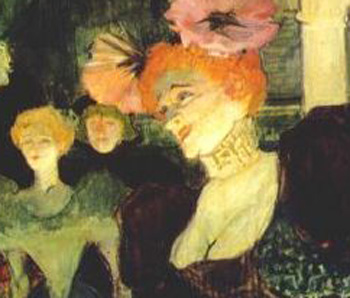
Behavior
 EXUBERANCE
EXUBERANCE

Not to be confused with hypomania.
by John McManamy

Not to be confused with hypomania.
by John McManamy
FROM MY BOOK: NOT JUST UP AND DOWN ...
Is “up” your true normal? Consider the following …
Two women are dancing on tables. It's not the dancing on tables that is at issue—it's who is dancing on tables. One is Marilyn Monroe. The other is your stereotypical librarian. Marilyn is obviously just being Marilyn. It’s the librarian we need to worry about. Then again, she may be fine.
“I hate to tell you this,” a good friend of mine told me. “You’re normal.”
The bottom dropped out of me. Normal? Normal is a word you only want to hear after you’ve had a colonoscopy. My mother once sat me down on her knee and said, “Son, there’s no excuse for dancing like a white man.” Okay, I’m making that up, but seriously, who wants to be normal?
No insult to this fine group of individuals, mind you. Some of my best friends are normal. Wait—what the hell am I talking about?—no they’re not. These people bore the crap out of me. Screw them, I avoid them like the plague. I mean, has anyone ever said to you: “You’re in for a special treat. We’re going to meet some incredibly normal people.”
But that’s not what my friend meant by normal. Kay Jamison’s 2004 book Exuberance offers some insight. “We have given sorrow many words," she writes, "but passion for life few." Exuberance, she says, "takes us many places," with "delight its own reward, adventure its own pleasure."
These are people who tend to see their work as play. "I can’t understand why they pay me to do what I love," Robert Farquhar of the Johns Hopkins Applied Physics Laboratory told Dr Jamison. In 2001, he and his team successfully landed a spacecraft on the asteroid Eros. His enthusiasm, he said, gave him the staying power to persevere over the NASA bureaucrats, who would have been satisfied with a mere orbital mission.
Dr Jamison also mentions the author Virginia Woolf, best remembered for her madness and suicide, who tends to be forgotten as the person who lit up London’s Bloomsbury Group. Said a colleague: "I always felt on leaving her that I had drunk two excellent glasses of champagne. She was a life-enhancer."
As much as society benefits from exuberant people, though, the world is also wary of them. As Dr Jamison points out: In The House at Pooh Corner, Rabbit and his cronies conspire to give the "too bouncy" Tigger a personality makeover and turn him into "a different Tigger altogether ... a Humble Tigger ... a sad Tigger, a Melancholy Tigger, a Small and Sorry Tigger."
Happily, the plan backfires, but that is not often the way things turn out in real life. Perhaps we can interpret this as a call to arms. Most of us know Dr Jamison as the author of An Unquiet Mind, which recounts her own struggles with mania and depression. But in Exuberance, she opens up to the joyous side of normal.
So where is our true normal?
Teddy Roosevelt was Dr Jamison’s exuberant poster boy. According to a Harvard classmate, "he zoomed, he boomed, he bolted wildly." A journalist said that after you went home from a meeting with him you had to "wring the personality out of your clothes."
In her book, Dr Jamison focuses on TR’s association with fellow exuberant, the naturalist John Muir, which set the stage for his legacy as a conservationist. But we can also make an argument that TR was an accident waiting to happen. Woodrow Wilson characterized him as “the most dangerous man of the age,” and Mark Twain described him as “clearly insane.”
This was a man whose unbounded enthusiasm led the US into one high-stakes imperialist venture after another. Fortunately, he never met his Vietnam.
SIGN UP FOR MY FREE EMAIL NEWSLETTER
Fast-forward to the end of 1967 and Time magazine’s Man of the Year cover, with Lyndon Johnson caricatured as Lear. “A sovereign shame so elbows him,” said Kent in the play. “These things sting His mind so venomously.”
LBJ had met his Vietnam. Like TR, he was constantly “up” and enjoyed a lifetime of one success after another.
Probably no President accomplished more to greater lasting effect in his first three years in office than he had. Then in 1965 he decided to massively increase troop levels in what looked like a low-risk foreign intervention.
The decision was a rational one, made in consultation with his advisers. But by 1966, it was clear his position was untenable. In her 1976 book, Lyndon Johnson and the American Dream, historian Doris Kearns Goodwin recounts his unraveling:In the past, Johnson had displayed a fine sense of discrimination about his political opponents, recognizing his enemies today might be his allies tomorrow. Now he became unrestrained and reckless, creating a fantasy world of heroes and villains. Members of the White House staff who had listened to the violent name-calling were frightened by what seemed to them signs of paranoia.
Three months following the Lear cover—virtually unable to govern and with his popular support eroding by the day—Johnson announced that "I will not seek, nor will I accept, the nomination of my party for another term as your President."
He left office at the beginning of 1969, never to return to public life. He died four years later, an embittered and broken man.
Both TR and LBJ would easily meet the DSM criteria for hypomania. Just start with symptom number one—“inflated self-esteem or grandiosity”—and work your way down through “decreased need for sleep” and “more talkative than usual” and so on to “excessive involvement in activities that have a high potential for painful consequences.”
From there, it is tempting to go through their lives to find a period where they may have experienced depression (TR certainly did), then retrospectively diagnose both of them with bipolar. But as tempting as it would be to claim two ex-presidents as members of our club, the truth is they were far too busy leading successful lives over an unbroken succession of decades for them to ever consider finding common cause with us.
Trust me, you won’t find people with TR or LBJ qualities in bipolar support groups.
No, the real bipolar lesson is far more elemental and profound—we’re “normal.” It’s just that in our particular versions of normal, our thoughts and feelings run a lot wider and deeper. Once we’re on board with this, we are free from the tyranny of symptom lists and all those who point fingers in our direction. But we also need to acknowledge that wider and deeper is not always a blessing. In this sense, we’re all accidents waiting to happen.
Dr Jamison used the term exuberance. Hagop Akiskal refers to “hyperthymic.” Hyperthymic is the “trait,” hypomania the “state.” On the surface, the two appear exactly the same, but the first represents one person’s “normal,” the second another person’s not-so-normal.Recall Marilyn and the librarian dancing on tables. Marilyn is the “normal” one in the room.
But, as Dr Akiskal notes, taking his lead from Kraepelin, hypomanic and manic states may arise out of hyperthymic traits.
This may have happened to Marilyn when her life unraveled at the very end.
A good doctor, of course, will work with you in finding your way to your true normal. The catch is your doctor’s version of normal is likely to be very different from your own version, especially if her first impression was when she observed you bouncing off of walls and ceilings in a hospital ward.According to John Gartner, associate professor at Johns Hopkins and author of the 2004 book, The Hypomanic Edge, writing in a July 2011 blog piece on Psychology Today, most patients with bipolar II regard their hypomania—what Dr Akiskal refers to as hyperthymia—as part of their temperament. They were born that way and have lived that way since they can remember. Writes Dr Gartner:
It is the source of their energy, creativity, productivity and identity. All they want is to be a better adjusted version of themselves. Trying to turn them into people of normal temperament is about as sensible and humane as trying to make a gay patient straight.
But your doctor doesn’t trust “up,” and neither does society. This, I submit, accounts for most treatment failures in bipolar. A 2003 study co-authored by Jan Scott of Newcastle University found a major disconnect between doctors and their patients. The psychiatrists in the study thought that bipolar patients went off their meds because we "miss our highs." The patients who quit cited other reasons.
You can imagine how this went over at my first and last grand rounds ever in Princeton, New Jersey.
So here I was, with the Scott study up on my PowerPoint, and my audience responding as if to the opening scene in “Springtime for Hitler.” It didn't help when the next thing out of my mouth was: "Get over it. When your patients complain to you about feeling like fat stupid zombie eunuchs on the meds you prescribe—and on the meds you overprescribe—they are not doing this to ruin your day."
To this day, I have no idea why they headed for the exits the second my lips stopped moving.
NEW!
Follow me on the road. Check out my New Heart, New Start blog.












